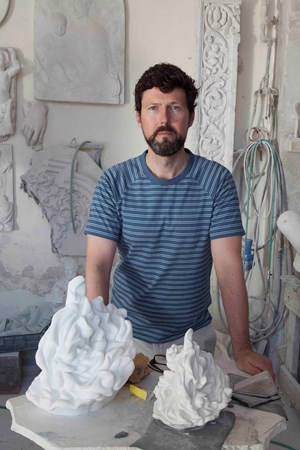
Richard Stone is a multi-disciplinary artist whose practice transcends both painting and sculpture and has also included installation and performance. He works between London and Pietrasanta, the centuries old home of Italian marble carving, where it is believed that Michelangelo travelled from Florence to buy the marble for David.
Richard Stone is a multi-disciplinary artist whose practice transcends both painting and sculpture and has also included installation and performance. He works between London and Pietrasanta, the centuries old home of Italian marble carving, where it is believed that Michelangelo travelled from Florence to buy the marble for David. Stone seems to explore notions of statelessness and transformation using abstract forms with classical touch. He studied at Central St. Martins, London and was awarded a British Academy full bursary. Since then he has been recognized by Arts Council England, The Royal Society of Sculptors and selected for many awards and prizes. ArtDependence Magazine talked to Richard Stone about his sculptures, inspirations and challenges.
ArtDependence Magazine: Please tell us how you understood you wanted to become an artist. What was the turning point?
Richard Stone: There is so much that comes through in the different phases of making art, learning as well as experience that I always think it is about becoming an artist, rather than being an artist. Early on I guess, art was a subject I kept coming back to, I used to draw things directly, from nature and from natural history objects in school and it was here that I was really encouraged to pursue it further. But I do think, before I really knew what art was, it’s empirical potential always held my attention and I began to think and feel through it. I was always struck by the ephemerality of things, in nature, leaves falling, shadows moving, as well as emotional states and moods, how music and film can make you feel, make you euphoric as well as melancholy. I grew up on the English coast for good measure, which is very cyclical. People arrive in spring and summer and people leave in autumn and winter, the weather changes dramatically. There are these distinct points of being between things that I think has influenced my thinking and making, too.
AD: Why have you chosen to work with sculpture, amongst other media?
RS: That is something that has come to me over a long period of time. I have always used a really broad range of materials and processes that have had sculptural elements to them and I have worked in installation too. Sculpture in recent years though has become very present, much more powerful to me. It consistently draws me in and I am very connected to the materials I use to get to it. I often want to capture something elusive, intangible in sculpture and this is an incredible challenge for me. I think that is why I would say that making sculpture makes me very still, very contemplative, whereas making painting often makes me very physical, emotional, when these states crossover, it is often interesting in the studio.
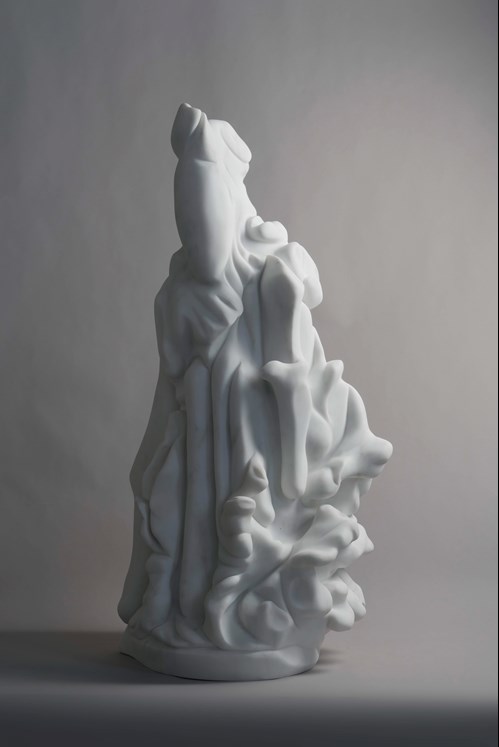
Richard Stone, Tutelar, 2018. Statuario marble, 95 x 50 x 50 cm
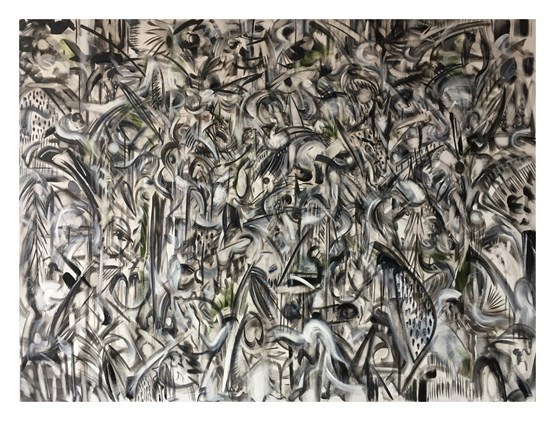
Richard Stone, His key monochrome, 2018
AD: Your works in sculpture look warm and elegant, even fragile despite the fact that you work with stone. How have you managed to achieve this effect?
RS: You know, I think you make a really pertinent point when you reference a warmth and elegance in the sculpture, I see a lot of sculpture at the moment that has a digital feel to it and it feels cold. I have always been drawn to the sensuality of things and this is often guided by the materials I use. With sculpture, I often start with clay, I never make any preparatory drawings, I rarely use armatures either. Instead, I go straight to the clay first and see what it wants to yield in that moment, a sculpture emerges, or it doesn’t. I often have to work with the possibility of the clay collapsing without an armature and I think this lends it a natural fragility as well as a strength that comes through when I translate the finished clay model into another material, like it has survived or something and I think in this sense, this contributes to the effect you describe.
I think slowness too, is incredibly, increasingly important, in life as it is in art. I think the movement I am able to create in my work is very intuitive and naturally expresses this, because I almost stop thinking when I start to make a work. It is like my mind moves to the point of being able to have a genuine, unhindered conversation between psyche and physical material. This does not mean that my work doesn’t have natural rhythm and great energy and a lot of my works do but I think I am keenly connected to this state I make my best work in. A viewer of my work once said it had the feel of film stills, still and slightly grainy, but you could still get to the essence of what the rest of the film might look and feel like. I immediately connected with this, not because I have ever set out to create this way of people seeing my work, but because I think there is a natural resonance in frozen moments, including of captured movement, connecting with how we experience things, often in memories and fragments rather than anything linear.
AD: What is your artwork about?
RS: I have always worked with and against the classical canons of the figure and landscape, but most recently, themes have emerged about notions of statelessness, collapse and transformation. I am not political but I do not exist in a vacuum either and there are echoes of wanting to transcend the current world order, to connect to something ancient, but universal, to nature perhaps.
I have an eclectic style, you will easily find a marble sculpture of an abstracted sufi dancer next to a painting with leitmotif animals traversing a forest, or pale landscapes next to exotic birds and foliage, but what unites them is a real interest in emotional transactions, how form and mark making is its own unique language but one that also belongs to all of us. I think in my new works, nature emblems, both English and exotic, move in and out of view, traversing at points, so much so that I think they might burst out of the canvas and back into the world itself.
I also think it is about what you mention before, about fragility, that is starting to get to the essence for me of what it is like to be in the world right now. I do not want to overly describe or communicate that because that would shut meaning down and I have always been drawn to liminality, of meaning between things, ambiguity.
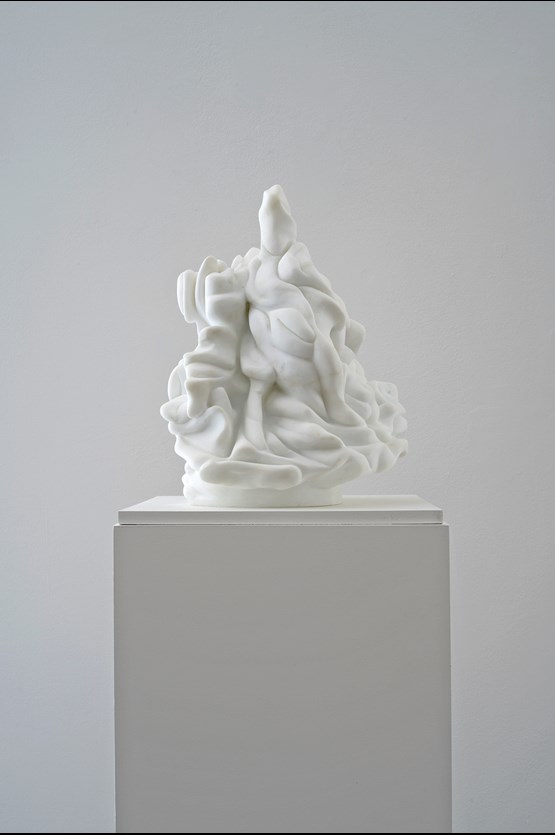
Richard Stone, I want to be a sufi dancer
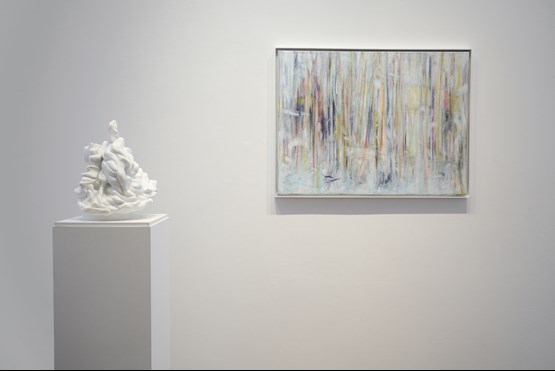
Richard Stone, I want to be a sufi dancer, Passing through a parlour of winter trees
AD: Why do you prefer abstract over figurative form?
RS: My work often hovers at that exact point when figuration or representation collapses into abstraction, but I think the possibilities of abstraction genuinely create more freedom for me to be in this time and across other times, in influence and expression. It also really functions as a way to explore past artistic styles and I really like the potential for specific historical art references to intertwine.
AD: In your opinion, what is the most difficult thing in being an artist?
RS: I have been incredibly lucky in recent years to be supported by my gallery and by a partner, friends and a network of assistants that help me get everything done. The most difficult thing, as with everything, is to balance priorities, have space to be creative, to earn enough to get by and to manage all of these relationships.
AD: What was your biggest challenge in art so far? What are you most proud of?
RS: Most recently, my biggest challenge was to scale up a porcelain model into a metre high statuario marble sculpture. This was incredibly challenging and I had to completely entrust my vision to incredibly knowledgeable artisans to help realize a very complex work, with life in every fold and form.
Before that, quite recently too, I learned bronze casting for the first time, in Pietrasanta, Italy, which was a whole new world, but opened so many doors and I remain incredibly proud of the achievements I made by seizing a new opportunity of learning and experience, again with people with many years of experience.
AD: Do you have any other passions besides art?
RS: I have a real case of fernweh and music is a total passion.
Richard Stone is set to release new works including marble figure tutelar, at Art Brussels 50th anniversary art fair, which runs Thursday 19th April – Sunday 22nd April, 2018. More here.
All images are courtesy Richard Stone.

ArtDependence Magazine is an international magazine covering all spheres of contemporary art, as well as modern and classical art.
ArtDependence features the latest art news, highlighting interviews with today’s most influential artists, galleries, curators, collectors, fair directors and individuals at the axis of the arts.
The magazine also covers series of articles and reviews on critical art events, new publications and other foremost happenings in the art world.
If you would like to submit events or editorial content to ArtDependence Magazine, please feel free to reach the magazine via the contact page.